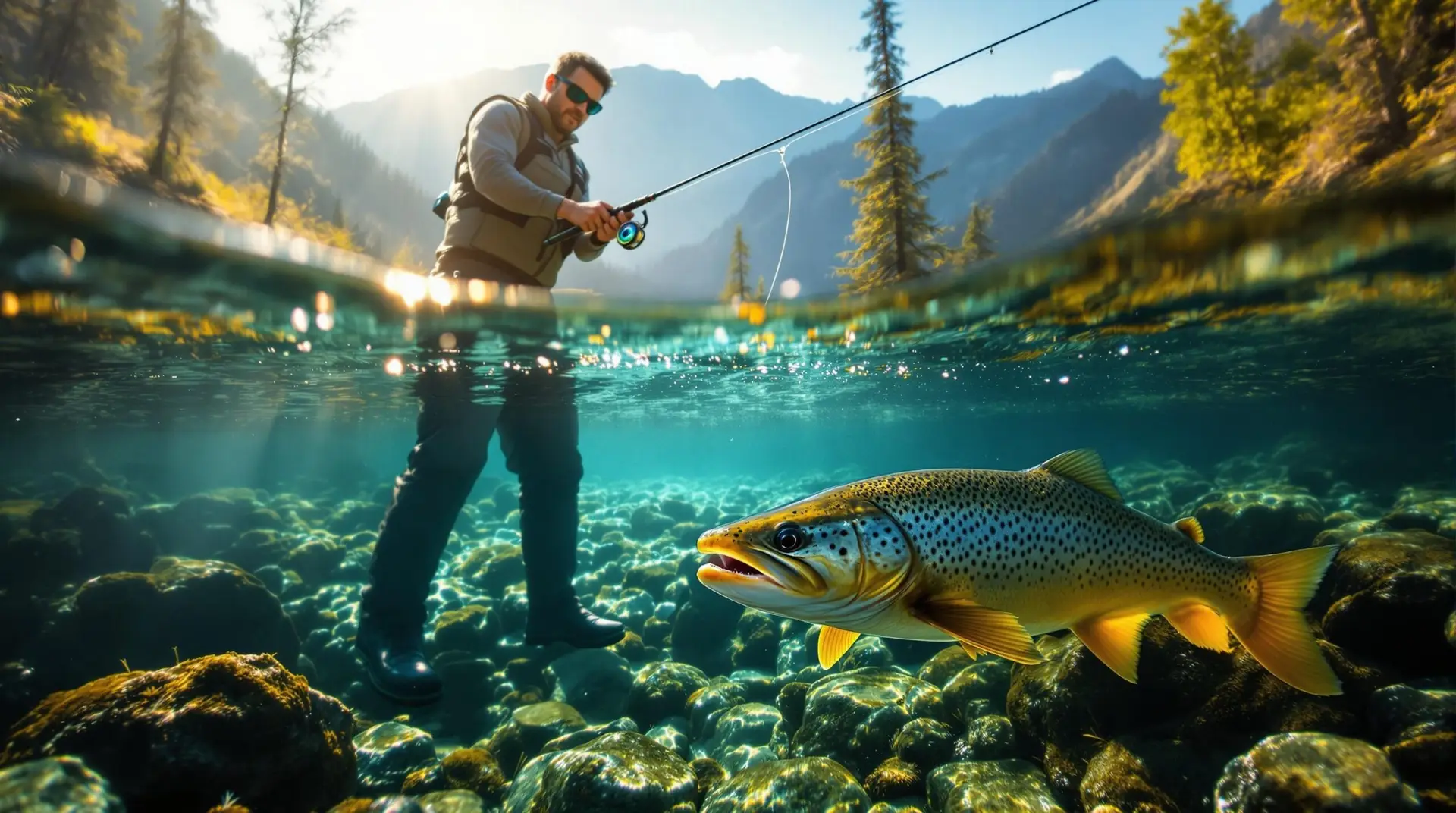Mastering Euro Nymphing
Techniques for Precision
Euro nymphing is all about snagging fish with finesse. Instead of the old school indicator, you’ve got this colored filament called a “sighter” to spot bites. It helps you get sneaky with the fly, perfect for when you’re after those clever bruisers that know how to play hard-to-get.
Key techniques to make your Euro nymphing deadly accurate:
- Keeping It Tight: Stay in touch with that line. You want no slack so when a fish checks out your fly, you’re ready to pounce.
- Drift Control: You’re the puppet master. Make your flies dance like bugs for the fish. Master how to do it here: nymph drift mechanics.
- Watch the Sighter: Train those peepers to catch every little quiver of your sighter. It’s a must-have skill to know when those sneaky fish are biting, especially in rapid or deeper waters like these deep water nymphing.
Equipment for Success
Getting the right gear isn’t just about tossing around fancy equipment. It can make or break your Euro nymphing game, especially when you’re looking to kick tail in a contest.
Rods
Rods in the 2, 3, and 4 weight range are favorites. They let you use light lines for a smooth drift and prevent snapping fish off during a strike. Longer rods, around 10 feet, are gold. They allow you to fish over currents with ease.
Need recommendations? Check out best euro nymphing rods.
| Rod Weight | Ideal Use |
|---|---|
| 2 Weight | For those super light vibes |
| 3 Weight | All-rounder, nice balance |
| 4 Weight | For when it gets heavy with strong currents or big flies |
Reels
Euro nymphing reels should be as rugged as they are light. Go for materials like aircraft-grade aluminum to keep things tough but not make your hand feel like lead. A smooth reel means fewer tangles.
Look up more options at euro nymphing tools.
Lines and Leaders
For nymphing, special lines and leaders are crucial. They help with casting delicate flies, keeping sensitivity high, and making sure you catch every nibble.
- Euro Nymph Lines: Skinny lines mean less battle with the water.
- Leaders: Long, straight leaders give you control and cut down drag.
Need a deep dive into choosing lines and leaders? Check out best comp nymphing lines and nymphing leader setup.
Additional Tools
- Sighters: Your go-to for spotting any action.
- Weights and Beads: Tungsten beads come highly suggested for their heavy, sink-quick qualities.
- Indicators: Use micro thin indicators for a stealthy rig (best nymph indicators).
Want to get even more advanced? Check out guides on advanced euro nymphing and technical nymph fishing. These resources spill the secrets for fly fishers ready to excel in the nymphing game.
Understanding Euro Nymphing Lines
Euro nymphing lines are a big deal in serious fly fishing circles. They’re all about finesse and precision, offering some cool perks for those looking to up their game in the competition scene. Let’s talk about why these lines are worth your attention and how to pick the right one for your rod.
Benefits of Euro Lines
Euro lines, also called tactical fly lines, are thinner than your average line—about the width of a spaghetti noodle. They were whipped up initially to comply with some pretty strict competition rules about leader lengths (Troutbitten).
Here’s why Euro lines are making waves:
- Heightened Feel: The slim build of these lines means you can feel even the tiniest nibble from a sneaky fish.
- Smooth Sailing: The lean leaders make for smoother drifts, letting you cast lighter flies farther than the chunkier lines can manage (Troutbitten).
- Less Tangle Trouble: In colder temps, Euro fly lines don’t turn into a tangled mess like some other rigs. Always give your Euro line a good stretch before you start casting.
Choosing the Right Core Material
Picking the right Euro nymphing line hinges on the core material, which comes in two flavors: monofilament and braided. Each brings its quirks to the table.
Monofilament Core
- Heft: A mono core usually tips the scales at around 8-10 lbs.
- Bend but Don’t Break: Offers a mix of strength and flexibility, making casting a breeze.
- Durability: Handles all sorts of fishing conditions like a champ.
Braided Core
- Casting Quality: Braided cores are a bit lacking when it comes to powering through a cast.
- Fishing Technique: They can cramp your style, especially if you’re dealing with tricky casting techniques.
- Cold Weather Woes: These lines love to tangle more when it’s chilly out, so they’re not top picks for winter.
| Core Material | Weight (lb) | Turnover Power | Flexibility | Coil Control |
|---|---|---|---|---|
| Monofilament | 8-10 | Fantastic | Superbly | Great |
| Braided | 8-10 | Meh | So-So | Not So Great |
Figuring out which Euro line suits you best involves knowing what each core offers you in terms of feel and performance on the water. For more on hooking up the right gear or honing your fishing techniques, check out our deep dives on advanced euro nymphing, contact nymphing technique, and nymph rig weight placement.
Strategies Beyond Competition Rules
Alright, let’s dive into the world of fishing that doesn’t stick to the rulebook. This is where the real fun begins, exploring tactics that take your Euro nymphing game to a whole new level.
Enhancing Nymph Weight
So, here’s the deal. In competitions, anglers gotta follow some strict rules, like no extra weights on the leader—just those chunky flies with big beads. But outside that world? The gloves are off!
Add some weight, crank up the efficiency, and face tougher waters with more confidence.
Split Shot, anyone?
- Toss a split shot on your leader and you’re the boss of nymph depth.
- Swap the placement around and control how fast and where your nymph slides through the water.
How about some Tungsten Putty?
- Mold this stuff to fit the mood of the river.
- Need a quick change? No sweat. No need to cut the tippet constantly.
| Method | Upside | Downside |
|---|---|---|
| Split Shot | Super easy, Move it anywhere | Might hurt the leader, Toss your casting a bit |
| Tungsten Putty | Spot-on adjustments, Leader friendly | Watch out for losses, Messy business |
New Tactics to Try
Step outside the competitive circle, and a variety of fishing tricks becomes your playground. Here’s how you can really pump up your Euro nymphing skills.
Short Line Nymphing:
- Keep it close and take control. Spot strikes faster.
- Especially handy in fast or pocket water where time isn’t on your side.
High Stick Nymphing:
- Hold that rod up high, minimal line in water, nailing drifts over tricky currents.
- A solid move for deep, rough patches of water.
Pursing Indicators:
- Get visual clues without messing up the nymph’s groove.
- Handy when the water’s murky or when using lighter flies.
Pairing these tactics with just the right weighted nymphs lets you tackle a wide bunch of fishing setups. Need tips on weight secrets? Check out our advice on nymph rig weight placement.
With these strategies under your belt, watch as your nymphing skills skyrocket—taking your success rates and flexibility to new heights in different fishing scenes. For deeper insights and specific techniques, hop over to our pages on advanced euro nymphing and contact nymphing technique. Get ready to build some fishing stories worth bragging about!
Fine-Tuning Your Nymphing Rig
If you’ve been fishing long enough to feel like an expert or competitor, you already know that fine-tuning the nymphing rig can really amp up your fishing game. Picking out the perfect fly and crafting a smart leader are steps you don’t want to skip if you’re set on getting those fish jumping into your net.
Picking the Right Fly
Choosing the right fly is like picking the right bait at a buffet – you gotta match it up with what’s on the menu for those fish. You won’t find a one-size-fits-all fly here; the perfect fly depends on what’s happening in the water. Current, depth, hatches – you name it, it all matters.
In competitions, folks often go for flies with whopping big beads and dramatic designs. Why? They’re heavy enough to get down deep fast, no extra weights needed.
| Fly Type | Bead Size (mostly used) | When To Use |
|---|---|---|
| Standard Nymph | 2.5mm – 3mm | Everyday situations |
| Heavy Nymph | 3mm – 4mm | For faster or deeper waters |
| Micro Nymph | 2mm – 2.5mm | Slower or shallower waters |
Those beads really make a difference in how your fly sinks. Like, over in Australia, a 3mm bead’s pretty popular – but might change depending on where you’re at.
Want more tips? Check out our guide on nymph pattern selection for the whole scoop.
Building a Smart Leader
Designing a killer leader is key to making your nymphing rig rock solid. The mission? Cut drag, nail the drift, and spot strikes the moment they happen. Forget about those bulky fly lines; it’s all about keeping it lean and mean with just one skinny tippet below the water surface (Troutbitten).
When you’re competing, thin tippets like 6X or 7X are where it’s at. They let your fly dance in the current with less hold up and get down to business quicker.
| Leader Part | What We Recommend | Why You Need It |
|---|---|---|
| Main Leader | 9ft – 12ft, 2X – 3X | Strength meets flexibility |
| Tippet | 6X – 7X | Slim diameter resists drag |
| Sighter | Bright material, 8in – 12in | Helps spot the bites |
For a full guide on crafting a top-notch leader for nymphing, see our nymphing leader setup guide.
Whether you’re strapping on a multiple nymph rig or perfecting a precise layout, fine-tuning that nymphing setup with the right flies and leader touches will definitely set you up for success in technical nymph fishing.

